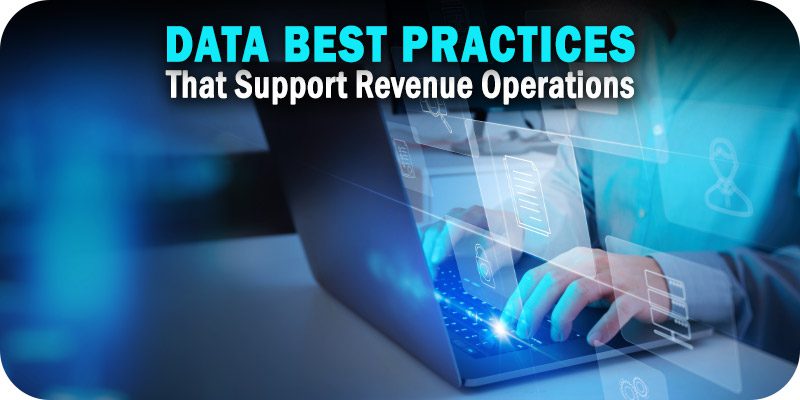3 Data Best Practices That Support Revenue Operations


As part of Solutions Review’s Contributed Content Series—a collection of contributed columns written by industry experts in maturing software categories—Lyndsay Cook, the VP of Marketing at ClickDimensions, outlines three data best practices that can support a company’s revenue operations (RevOps) teams.
Today’s B2B customer journey is complex, spanning many different channels and requiring an estimated 6-8 touchpoints to convert a lead. Prospects now typically complete heavy research about a company before making contact or a touchpoint takes place. Driven by these two shifts in the buying and selling landscape, marketing and sales teams must unify their efforts to track the ever-evolving customer journey. One way for unified sales and marketing teams to be more impactful in tracking prospects’ behaviors and outcomes is to evolve from a sales-focused organization to a revenue-focused one. This is where revenue operations take shape.
A revenue operations (RevOps) model unites people, processes, and data across various business functions to create a cohesive consumer experience that results in revenue generation. To be truly effective, this shared revenue goal must be supported by a shared technology stack that automates marketing and sales activities and allows for greater targeting, nurturing, and personalization.
This brings us to the driving force behind RevOps: data. The success of your RevOps strategy hinges on your organization’s data because it’s the cornerstone of cross-functional unification. To boost revenue in today’s non-linear, digital-first buying journeys, your sales and marketing teams need to operate from accurate shared data.
If you’re unsure where to start, here are three best practices.
1) Ensure Data is Clean
At any given time, it’s estimated that the average B2B database is 25 percent inaccurate. As a business, what exactly does this cost you? According to Gartner research, the financial impact of poor data quality on organizations is about $12.9M annually. Aside from the noticeable impact on revenue, sub-par data can lead to poor decision-making, lost leads, and a misunderstanding of customers and customer relationships.
Start with a data assessment to discover the current state of your data quality. This will help you understand the value of your data and provide a detailed plan for your data, systems, and processes to build a high-quality data foundation that can set you on a path to more effective revenue generation.
Clean and complete data is the apex for effective revenue generation. Businesses require actionable analytical insights to drive decisions, and those insights rely heavily on clean and structured data. Clean data is also fundamental to answering critical questions like which contacts are missing necessary fields or which channels drive the most conversions. Once you have visibility into your data quality, you can build a cohesive customer experience.
2) Enrich Your Data for Greater Insights
The next best practice for data in a revenue operations model is enrichment. Data enrichment takes a company’s raw, first-party data and merges it with trusted, third-party data to help organizations better understand their customers and gain deeper insights into their behaviors. For example, when the data from your CRM database, marketing and sales automation systems, and website analytics is combined and enriched with the correct externally-sourced data, it unlocks access to a rich resource of information from which to derive actionable business decisions.
From a marketing and sales perspective, enriching data enables an agile marketing strategy informed by a nuanced view of prospects and their behaviors. It builds deeper customer profiles and helps marketers and salespeople build highly granular audience personas. This process is also essential because it equips sales and marketing teams with more knowledge about prospects without asking them for extra information.
When you have a deeper understanding of your prospects and their buying behaviors, you can tailor your strategies, be more impactful with your interactions, and effectively carry them through the funnel and drive revenue.
3) Unify Data Sources
Many businesses still operate with siloed data, where the CRM data and other tools in the tech stack don’t integrate or connect properly. This is like having puzzle pieces that never fit together correctly. The fragmented data approach prevents seamless lead hand-offs, hinders the nurturing process, and can impede personalization efforts. It also increases the chances of sending irrelevant or repeat information to potential customers.
Achieving a single source of data is a process that takes time. Eighty percent of businesses admit to struggling with it, but it’s necessary to perform data alignment to support revenue operations.
In a RevOps model, organizations need to establish one single data source where all information is stored, sorted, shared, and accessed by both marketing and sales teams. This empowers RevOps with a comprehensive list of customer interactions like email campaigns, sales calls, and form submissions. When all groups have the same view of the prospect and actions taken throughout the funnel, they can better predict what they need next to create better customer experiences and improve conversion outcomes.
Becoming Data-Driven
Data is the critical component that powers revenue operations, but only 26 percent of companies report being data-driven or making strategic decisions rooted in data analysis. This means that most companies trying to implement a RevOps strategy run into roadblocks before they can even begin. To position your organization for success, you must invest in cleaning, enriching, and consolidating data into a singular view. By following these best practices, you set that path for RevOps success and arm your sales and marketing teams with the tools they need to make it happen.





















